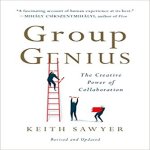Group Genius
- The most innovative teams were the ones that spent less tiem in the lanning stange and more time executing- instead of planning, they intmpovised (1) – page 28
- Unclear objectives became the biggest barrier to effective team perofmrance (2) – page 44
- Team autonomy is the top predictor of team performance (3) – page 49
- Supervisors generally sapped flow (4)… Familiarity inreases productivty and decision making (5) – page 51
- When solving complex, non-routine problems, groups ar emore effective when they’re compseod of people who have a variety of skills, knoweldge, and perspective… the most innovative banks were those with teams that had many forms of expertise (6) – page 71
- The group reward condition resutled mostconsintelny in ghi eprfomrance (7) – page 72
- People are more creative if, instead of simply being tld the answer, they actually solved a similar problem themselves… you store information in a different way when you solve a problem than when you passively receive information (8) – page 89
- Students who were given a problem to solve on the first day that held a similar answer to the problem given on the second day were more likely to be successful (9) – page 93
- In every creative domain, most people are somewhat unproductive, and a small minority are super productive… 10 percent of scneitsts write 50 percent of articles (10) – page 107
- None of those who didn’t hear the fortres story were able to solve the x-ray prbolem (11) – page 112
- Team-based companies performed better than traditonal beaureaucratic firms (12)… Cross-functional, collaborative groups called inovation labs, made up fo people from different corporate functions repreasenting all stages of devleopment, result in quicker poduct development times (13) – pages 155-157
- The collaborative organization constantly experimented and they awlys had several different low cost projects… they responded to what emerged… the noninnovative companies dealt with the future by planning the future = spending months on strategy and product devleopemnt plans… if the future didn’t unfold according to their plan, they wre doomed to fail (14)… 3M, Gore, and Google reserve from 10 to 20 percent of each employee’s time for innovative new projects (15) – page – page 161
- One of the stores found a solution to the deep dish pizza problem… within weeks all 36 stores had adopted the inovation(16)… Half of innovations were stimulated by new job assignments… more interconnection led to greater innovation (17) – pages 170-171
- One percent of the top 500 open source software projects were radical innovation… themajority were taking an existing product and making incremental improvements (18) – page 201
- Annual sales at 3M of products that emerged from users were eight times the annual sales of producs devleoped in house in the tradinal way (19) – page 209
- 38 percent of mountain bikers had an idea for how to improve the bikes, and an expert panel detemriented that about 30 percent of these ideas had market potential (20) – page 211
- 45 percent of innovation came from outside the major companies (21) – page 217
References
- Accelerating adaptive processes product inovation in the global computer industry
- Building high performance engineering project teams
- Coordination in energy in conversation
- Charged up creating energy in organizations
- Flow in knowledge work: performance experience in the desig of national securty technology, The role of tacit knowledge in group innovation
- Teams in organizations: recent research on performance and effectiveness, Top management and innovations in baking does composition of the top team kae a difference, From guilford to creative synergy opening the black box of tea level creativity, Learning and performane in multidisplinary teams the importance of ollective team identification, Developing diversiy lessons from top teams
- Interdependence and group effectivness
- Conceptual transfer in simple insight problems
- Priming and awareness in complex reasoning
- Creative productivity a predicitve and explanaotry model of career trajectories and landmarks
- Analogical problem solving
- Teams in organizations recent research on performance and effectiveness
- Accelerating adaptive processes: product innovation in the global computer industry
- The art of continuous change: linking complexity theory and time paced evolution in relentelssly sifting organizations
- Managing innovation when less is more
- The acquistion trasnfer and depreciationof knowledg ein sericce organiztions roductiveity in franchises
- When a thousand flowers bloom: strucutral colelctive and social condition for innovation in organization
- Innovativeness of open source software project
- Performance assessment of the elad user idea gneration rpocess for new producr devleopment
- The Dominant Role of “Local” Information in the User Innovation The Case of Mountain Biking
- Toward an innovation sourcing strategy, The ne organization
